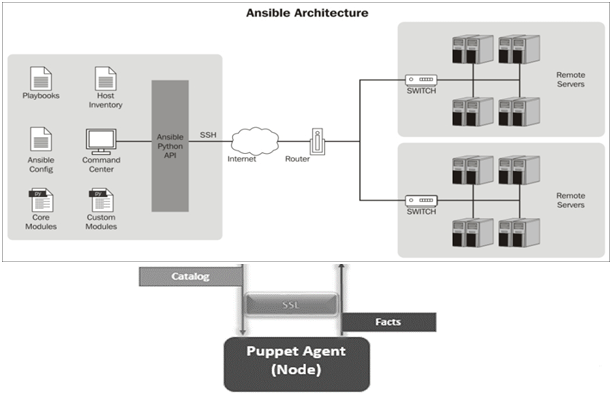
Ansible is an open-source computerization tool that robotizes software provisioning, configuration management, and application deployment. Michael DeHaan, author of provisioning server application Cobbler and co-author of Func structure for remote organization. Built up platform. It incorporated as a feature of Fedora dispersion of Linux, claimed by Red Hat Inc., and additionally accessible for Red Hat Enterprise Linux, Cent OS, and Scientific Linux by means of Extra Packages for Enterprise Linux (EPEL) and in addition for other operating systems. Red Hat acquired Ansible architecture in October 2015.
Ansible Architecture:
Host stock record decides objective machines where these plays will executed. Ansible architecture setup document tweaked to mirror settings in your condition. Remote servers ought to have Python installed alongside a library named simple json on off chance that you are utilizing Python Version 2.5 or a prior form.
Playbooks comprise of at least one tasks that communicated either with center modules accompany Ansible or custom modules. That you compose for particular circumstances. The plays executed consecutively start to finish. So there is no explicit request that you need to characterize. Notwithstanding, you can perform contingent execution on assignments with goal that they can avoid (an Ansible expression). If conditions not met.
Inventory parsing
In Ansible, nothing occurs without a stock. Indeed, even specially appointed activities performed on localhost require a stock. Regardless of possibility, stock comprises just of localhost. Stock, most fundamental building square of Ansible design. When executing ansible or ansible-playbook, a stock must referenced. Inventories, either documents or indexes that exist on a similar framework that runs ansible or ansible-playbook. Area of stock referenced at runtime with stock record(- i) ion, or by characterizing way in an Ansible config file.
Inventories static or dynamic, or even a blend of both, and Ansible not restricted to a solitary inventory. Standard practice is to split inventories across logical limits. for example, staging and production, enabling a designer to run an set of plays against their organizing condition for approval. Afterwards follow same exact plays keep running against production inventory set.
Get in touch with OnlineITGuru for mastering Devops online training.Static Inventory:
It's just very simple. Just write down names of systems in your inventory. Obviously, this does not take full advantage of all that a stock that needs to offer. On off chance that if each name recorded this way. All plays would need to reference particular host names, or exceptional all gathering. This very long when developing a playbook that works crosswise over various arrangements of your infrastructure. At minimum level , hosts should arranged into teams. A plan design that functions best is to arrange your systems into groups of expected functionality.
At to begin with, this may seem to be troublesome. If you have an environment where single systems can assume a wide range of roles. However that superbly fine. systems in a inventory exist in more than one team. Teams even comprises of different teams. Furthermore, when posting gatherings and hosts, it's conceivable to list has without a gathering. These would need to recorded to start with, before whatever other gathering characterized.
Dynamic Inventories:
A dynamic inventory source (or plugin) is an executable script. That Ansible will call at runtime to discover real-time inventory data. This may reach out into external data sources and return data. Or it can just parse local data that already exists. But may not be in Ansible inventory ini format. While it is conceivable and simple to build up your own particular dynamic inventory source, Ansible gives various example inventory modules.
Design goals:
Insignificant in nature. Management systems forces not to force extra conditions on nature.
Ansible does not send operators to hubs. Just Open SSH and Python required to overseen hubs.
Exceptionally reliable. At point when deliberately composed, an Ansible playbook idempotent. It should noted, in any case, an Ineffectively composed playbook that not idempotent.
Low expectation to absorb data. Playbooks utilize a simple and graphic language based on YAML and Ninja formats.
Recommended audience:
Software Developer
System Admins
Who has exposure to automation
Prerequisites:
Get started by understanding its principles and tools you would need to learn to implement them. It’s a bit easy for Computer Science background people to pick up when compared to other branches. But anyone can master it with proper learning and training. Get in touch with OnlineITGuru for mastering the Devops training
